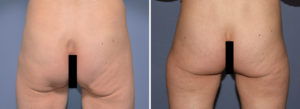Background: Sagging of the buttocks is a well known body change that can occur due to natural aging, weight loss or as a sequelae from buttock implant removal. While buttock sagging is a general term it has different types as defined by the level of the infragluteal fold. In type 1 buttock ptosis the infragluteal fold is at the right level and buttock tissue above it has fallen over it. In type 2 buttock ptosis it is the infragluteal fold that has dexcended carrying the buttock tissue down with it.
In either case of ptosis the most effective treatment is a lower buttock lift. As term implies, it is an actual lift created by the excision of tissue. Such tissue removal either removes overhanging buttock tissue, recreates the infragluteal fold at a higher level, or results in both effects. While effective the lower buttock lift creates a fine line scar along the infragluteal crease. Such a scar can be a minor aesthetic issue if well placed vertically and does not extend too far laterally. As long the excision/scar line does not get too close to the labia, there is not risk of labial deformity.
While the technique of lower buttock lifts has been described for decades, little has been written about its long-term persistence. It is presumed it is stable given that it involves a tissue excision, but it is in an area which is exposed to a lot of pressure and shearing forces on a regular basis.



Case Highlights:
1) Buttock ptosis is a natural sagging that presents as either sagging over the infragluteal fold or an dropping of the level of the infragluteal fold.
2) Regardless of the cause of buttock ptosis a lower buttock lift is the most effective approach to lower buttock rejuvenation.
3) Lower buttock lifts maintain persistent results as seen in this five year followup patient.
Dr. Barry Eppley
Indianapolis, Indiana



